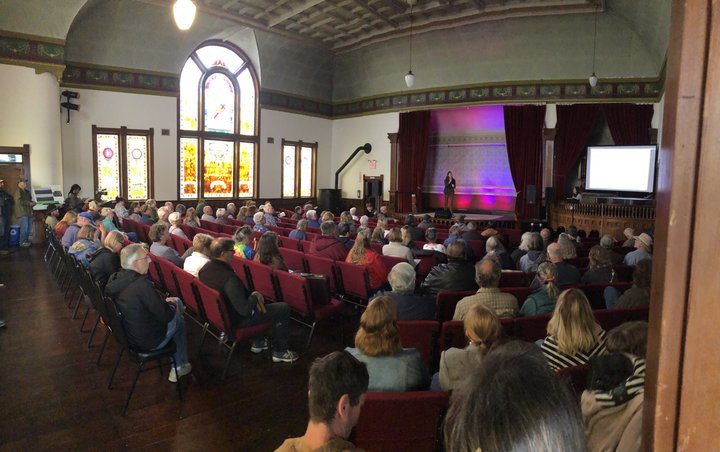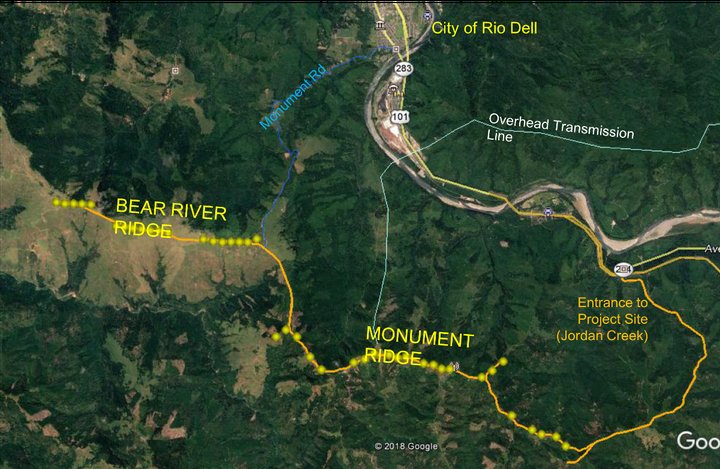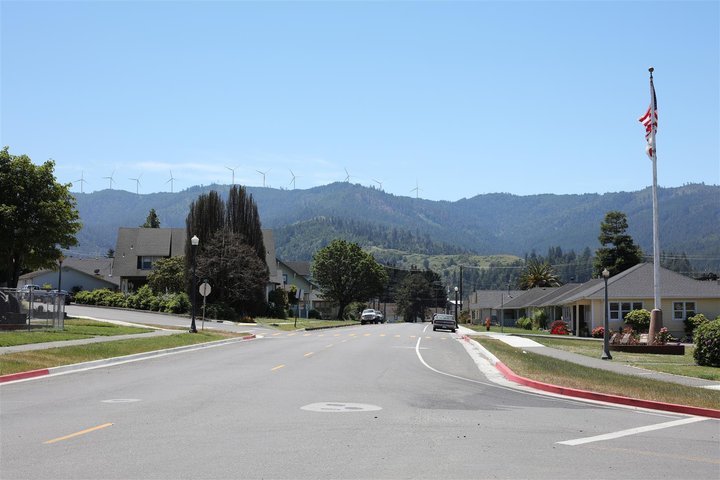
Natalynne DeLapp, community liaison for Terra-Gen, addresses the crowd in Ferndale. | Photo by Ryan Burns.
PREVIOUSLY
# # #
Proponents of a $200 million wind energy project held an informational meeting Tuesday evening, with roughly 100 local residents showing up at Ferndale’s Old Steeple to hear details of the project and voice their concerns.
The project, which was publicly revealed last fall, calls for up to 60 turbines — each as tall as 591 feet — to be installed along Monument Ridge and Bear River Ridge, south of Scotia and Rio Dell. Residents in attendance Tuesday night voiced concerns about the project’s impacts on the local community and the environment. Proponents, meanwhile, described it as a responsible means of energy production in the age of climate change.
Natalynne DeLapp gave the bulk of the evening’s presentation, beginning with a half-hour informational slideshow. DeLapp has been hired as community liaison for Terra-Gen, the renewable energy company behind the project, and she described herself to the crowd as a local, a Eureka homeowner who cares about the community and who did her homework on Terra-Gen before taking the job.
With California aiming for 100 percent energy production from renewable sources by 2045, projects such as this one are sorely needed, DeLapp said, noting that the state now gets more than half its energy from natural gas, with about 16 percent each coming from hydroelectricity and nuclear energy. Wind projects generate less than three percent of the energy consumed in the state, she said.
While Humboldt County is not generating much renewable energy of its own, the Redwood Coast Energy Authority, our region’s power purchaser and community choice aggregator, recently passed a resolution in support of getting 100 percent of the energy it sells from renewable sources by 2025.
“So RCEA can either purchase [that energy] from providers around the state, or they can buy a portion of the [energy produced by] the Humboldt Wind Project,” DeLapp said.
With that context laid down, she proceeded to give some details on the project, which we’ll summarize below.

A map showing possible locations for the wind turbines along with an access route along Jordan Creek Rd.
The goal, DeLapp said, is to build a project capable of generating 155 megawatts of energy. The turbines would be located on property owned by the Humboldt Redwood Company and the local Russ family, and lease agreements are already in place.
Energy transmission lines would run from the turbines to PG&E’s Bridgeville substation, 25 miles east.
A draft environmental impact report (DEIR) was released last month, and DeLapp assured the crowd that all the interested parties, including government agencies, tribes, environmental nonprofits and the general public, have been combing through the document and submitting comments to the county, which is acting as the lead agency.
“It is through our public engagement that projects are made better,” said DeLapp, who formerly worked as executive director of the Environmental Protection Information Center (EPIC).
The project’s 155 megawatt capacity is enough to power 72,466 households and provide about 36 percent of the county’s energy needs, DeLapp said, though she noted that the energy won’t necessarily stay in Humboldt County. RCEA is currently looking at a power purchase agreement, a public process whereby the agency can choose to buy all, some or none of the energy produced by the wind farm. Anything RCEA doesn’t buy would get plugged into the grid, but that agency will have “the right of first refusal,” DeLapp said.
The exact height, number and location of the turbines has yet to be determined. It will depend on feedback received from the public and concerned agencies. And DeLapp explained that this project has no connection to the wind energy project proposed by Shell nearly a decade ago, a project that fell apart amid intense public scrutiny.
While that project called for heavy equipment to be brought in through downtown Ferndale, the Terra-Gen project would barge the components into Humboldt Bay at Fields Landing, then haul them down Highway 101 to Jordan Creek Road, south of Rio Dell. (Two “minor bypasses” would be necessary to avoid bridges, and Terra-Gen is working with CalTrans and the California Highway Patrol, DeLapp said.)
From there the equipment would be hauled up a logging road on Humboldt Redwood Company land to the project site.
DeLapp introduced Yasmine Akky, a biologist and project manager with Stantec, the company performing wildlife research analysis, including extensive bird counts.
“They’ve done this really amazing marbled murrelet study,” DeLapp said.
According to Akky, the environmental analysis found that the turbines would “take,” or kill, as many as 20 murrelets over the project’s 30-year lifespan (“Realistically more like ten,” she said), while mitigation measures would effectively replace 70 of the birds. The project would also reduce the likelihood of oil spills in Humboldt Bay while helping to fight climate change, which provides its own threats to the species, Akky said.
DeLapp touted more prospective benefits, including the creation of up to 300 construction jobs and 15 permanent jobs. The energy produced would mean 372,000 metric tons of carbon dioxide avoided, equivalent to removing 80,000 cars from the road, she said. Terra-Gen would give the county $25 million in property tax revenues over the first decade and $76 million over the life of the project, plus $7.7 million in sales tax revenues, according to DeLapp.
She then showed a series of what she called “legally defensible visual simulations” — images created with a special kind of camera to illustrate exactly what the turbines would look like from various locales. The turbines would be visible from Rio Dell and Scotia, as shown in the simulation photo below, but would be hard to spot from most other vantages, judging by the images presented.

Simulation showing what it would look like from Scotia if large turbines were installed atop Monument Ridge. | File photo courtesy Terra-Gen.
DeLapp wrapped up her presentation by noting that the details of the project have yet to be finalized, and she encouraged attendees to submit their questions and concerns to the county.
But the assembled crowd had plenty of questions and concerns to direct at DeLapp, Akky and Kevin Martin, Terra-Gen’s director of environmental permitting, who was also on hand. And for the duration of the meeting these three fielded queries from the sometimes volatile and often skeptical audience.

Kevin Martin, Terra-Gen’s director of environmental permitting, Natalynne DeLapp, the company’s community liaison, and Yasmine Akky, a biologist and project manager with Stantec, on stage at Ferndale’s Old Steeple.
The public was encouraged to write their questions on index cards and pass them forward, but the process frequently got a bit chaotic as people shouted out questions from their seats.
One man asked whether Terra-Gen could someday come back with plans for a larger project, perhaps one with more turbines, and when Martin said they have no intention of ever doing so — that, if anything, they’d reduce the number as technology improved — the man bellowed, “That’s not the question!” Is it technically possible? he wanted to know.
Martin admitted that it is, though it would require PG&E to upgrade the capacity of its Bridgeville substation, something the utility has shown no interest in.
Akky addressed grassland mitigation, saying that in areas temporarily affected by construction the land will be fully restored while mitigation measures will be taken to compensate for the places where impacts would be permanent, such as roads and the turbine pads.
Asked how long it will take to complete the project, Martin said, “We’d like to get it done in 14 months.” When the crowd “oooh”ed in response he added, “If it was easy anybody could do it.”
One index-card question asked about the carbon footprint of the project from beginning to end, and how long it would take to become carbon neutral. DeLapp cited studies that have found wind energy projects generate between 18 and 25 times the amount of energy that goes into constructing them.
“You didn’t mention a timeline!” a woman shouted from the audience.
DeLapp said she’d have to get back to her on that.
“Who was the author?” a man called out.
“You didn’t address the question!” another hollered. “The question was: When will this project be carbon neutral?”
“I don’t have that off the top of my head,” Akky said, “but I can work with Natalynne to get that publicized.”
The man was not appeased. “The answer to that is obvious,” he said. “It will never be carbon neutral. We’re clearcutting 900 acres of trees — .”
“That’s an overestimate,” Akky interjected, going on to talk about the methodology used in the draft environmental document.
“It will never be carbon neutral,” the man repeated.
There were other testy moments. At one point a woman heard DeLapp refer to the “environmental impact report” and asked if it was the final report or a draft. When DeLapp acknowledged that she was referring to the draft the woman responded, “Okay, then you need to say it’s a draft environmental impact report. You’re not talking to dummies here!”
But generally the tone remained civil. Akky said she and her colleagues have been conducting acoustic monitoring for bats for over a year, and Martin gave an overview of the bird/bat conservation strategy spelled out in the DEIR. But inevitably there will be unknowns.
“There’s no certainty for siting a wind farm, no magic thermometer to stick in the ground to tell what the effects are going to be,” Martin said. The company plans to conduct “very close monitoring” even after the turbines are up and running as a means to minimize impacts to wildlife, he said.
DeLapp tried to reassure the audience that watchdog groups are going over the DEIR with fine-toothed combs. “All of the wildlife agencies, the minute this thing dropped they started reading it,” she said.
The public comment period on the environmental document closes on June 5. Comments and questions must be directed to:
Humboldt Wind Energy Project Planner
County of Humboldt Planning Department
3015 H Street
Eureka, CA 95501CEQAResponses@co.humboldt.ca.us
More information is available on the county’s Wind Energy Project Draft EIR webpage, and this Outpost story from April 15.
The Humboldt County Planning Commission is scheduled to review the project in late July.
CLICK TO MANAGE